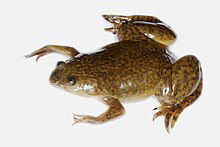
Back Gewone platanna Afrikaans قيطم إفريقي Arabic قيطم افريقى ARZ Обикновена ноктеста жаба Bulgarian Xenopus laevis BS Granota amb ungles africana Catalan Xenopus laevis CEB Drápatka vodní Czech Xenopus laevis Danish Krallenfrosch German
| African clawed frog | |
|---|---|

| |
| Scientific classification | |
| Domain: | Eukaryota |
| Kingdom: | Animalia |
| Phylum: | Chordata |
| Class: | Amphibia |
| Order: | Anura |
| Family: | Pipidae |
| Genus: | Xenopus |
| Species: | X. laevis
|
| Binomial name | |
| Xenopus laevis Daudin 1802
| |
| Synonyms | |
|
X. boiei Wagler 1827 | |
The African clawed frog (Xenopus laevis), also known as simply Xenopus, African clawed toad, African claw-toed frog or the Platanna) is a species of African aquatic frog of the family Pipidae. Its name is derived from the short black claws on its feet. The word Xenopus means 'strange foot' and laevis means 'smooth'.
The species is found throughout much of Sub-Saharan Africa (Nigeria and Sudan to South Africa),[2] and in isolated, introduced populations in North America, South America, Europe, and Asia.[1] All species of the family Pipidae are tongueless, toothless and completely aquatic. They use their hands to shove food in their mouths and down their throats and a hyobranchial pump to draw or suck things in their mouth. Pipidae have powerful legs for swimming and lunging after food. They also use the claws on their feet to tear pieces of large food. They have no external eardrums, but instead subcutaneous cartilaginous disks that serve the same function.[3] They use their sensitive fingers and sense of smell to find food. Pipidae are scavengers and will eat almost anything living, dying, or dead and any type of organic waste.
It is considered an invasive species in several countries, including across Europe.[4]
- ^ a b Tinsley, R.; Minter, L.; Measey, J.; Howell, K.; Veloso, A.; Núñez, H. & Romano, A. (2009). "Xenopus laevis". The IUCN Red List of Threatened Species. 2009. IUCN: e.T58174A11730010. doi:10.2305/IUCN.UK.2009.RLTS.T58174A11730010.en.
- ^ Weldon; du Preez; Hyatt; Muller; and Speare (2004). Origin of the Amphibian Chytrid Fungus. Emerging Infectious Diseases 10(12).
- ^ Christensen-Dalgaard, Jakob (2005). "Directional hearing in nonmammalian tetrapods". In Fay, Richard R. (ed.). Sound Source Localization. Springer Handbook of Auditory Research. Vol. 25. Springer. p. 80. ISBN 978-0387-24185-2.
- ^ http://www.science.org (29 March 2019) with populations becoming established , mostly likely, from people releasing pets into the wild: Amphibian fungal panzootic causes catastrophic and ongoing loss of biodiversity
© MMXXIII Rich X Search. We shall prevail. All rights reserved. Rich X Search
